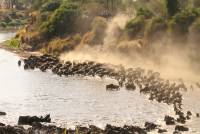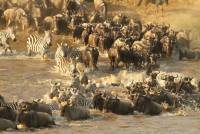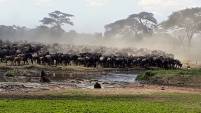Safari Calender
Tanzania is always worth the trip,
every season has it’s own special charm...
The tropical climate, which can be easily divided into rainy and dry seasons, ensures pleasant travel weather in Tanzania year round. Temperatures are rarely below 20 ° C during the Tanzanian winter and over 30 ° C in summer. The rainy season cannot be compared to the European one with continuous rain and cause an unpleasant trip. In Tanzania it rains briefly, fiercely and above all always very nearby. The scorching sun near the equator dries nature in no time.
Nevertheless, we are asked again and again, when is the ideal time to stay in Tanzania. Short answer: anytime! It just depends on what you want to experience. Arusha National Park, Manyara National Park, Ngorongoro Crater, and especially one of Tanzania's most beautiful parks. The Tarangire National Park offers wonderful safari experiences all year round, and Tarangire in particular should not be missed out on your safari program in any season.
The Serengeti is of course famous for the great migrations of wildebeest and zebras, ‘the Great Migration’. The recommended camps during each month provides the best starting point to see these large herds, but this does not mean that even in other months diverse game viewing is not a possibility because almost all camps have it. Elephants, antelopes, rhinos or buffalos do not adhere to the wildebeest and zebra migratory routes.
The following lines will explain the pros and cons of each month.
January
Average Temperatures: | 13-27°C |
Climate: | dry and hot |
Price range: | High Season |
Migration: | South-eastern Serengeti |
Migration Camps: | Kichakani South/ Kusini/ Lake Masek |
After the short rainy season in November / December, everything is fresh, the vegetation is still lush. The wildebeest are now in the southeastern part of the Serengeti. It is breeding season for many birds and numerous antelope species. The presence of predators is therefore high and nature offers spectacular hunting scenes. The other parks in Tanzania are all recommended for this season. The grass is still short and it is already so dry that the animals have to gather at the river to be able to absorb their daily ration of water From the middle of January, the large wildebeest and zebra herds move towards Ndutu.
February
Average Temperatures: | 13-28°C |
Climate: | dry und hot |
Price range: | Peak Season |
Migration: | Ngorongoro Conservation Area |
Migration Camps: | Kichakani South, Kusini, Lake Masek |
February is an excellent time in the Ngorongoro Conservation Area for game viewing and off-road safaris. The large wildebeest and zebra herds gather around the Ndutu Lake to drop off their young and the big cats follow them. The area around the lakes Lake Ndutu and Lake Masek, is ecologically already in the area of the flat wide Serengeti and is therefore excluded from any Maasai presence, but falls administratively still in the NCA. This means that it is allowed to drive off-road and get very close to the animals. The Tarangire National Park is an absolute must at this time of the year. Elephant herds of up to 200 are not uncommon on the river banks.
March
Average Temperature: | 14-27°C |
Climate: | dry/cloudy |
Price range: | Shoulder season |
Migration: | Moves towards Western Corridor |
Migration Camps: | Kichakani South, Kusini, Siringit |
March is a good time especially for photographic safaris. Although occasionally a few drops of rainfall the closer you get to the end of the month, but the cloud formation creates great moods and backdrops that photographers appreciate especially. The longer days in Europe reduces the influx of tourists to Tanzania. This gives photographers the opportunity to get the best shots of cats without being surrounded by a bunch of other safari cars. March is also a recommended travel date due to its lower prices. The fruits of the Marula tree are now ripe in Tarangire Park. The elephants now move from tree to tree in search of their favorite food and often stay close to the camps.
April
Average Temperature: | 15-25°C |
Climate: | Heavy rains alternate with sunny sections |
Price range: | Low Season |
Migration: | Western Corridor |
Migration Camps: | Soroi, Mbalageti |
In early April, the southeast monsoon brings "Kuzi", the so-called great rainy season. However, this does not mean for days, sad continuous rain, like in Europe, but sometimes very violent, but limited rainfall. In some regions, especially in the south-east, these can lead to heavy flooding and temporarily impassable roads. Africa shows its wild side of nature and offers fascinating natural spectacles. Of course it is still possible to see many animals on safari, and the bright colors and freshness of nature after the rain provide magical photo opportunities. It is the perfect time for bird watching. A special advantage of this season are the few tourists and the low prices of the camps and lodges, which benefit travelers who are not deterred by the warm rain.
May
Average temperature: | 14-23°C |
Climate: | Heavy rains alternate with sections of sunshine |
Price range: | Low Season |
Migration: | Western Corridor |
Migration Camps: | Soroi, Mbalageti |
The weather in May is similar to the weather in April. The vegetation is lush and high, which sometimes makes it difficult to see the smaller animals in the grass. The big rainy season is still going on. Just like in April, bird lovers will get their money's worth in May. The abundant food supply lets the birds eagerly build nests and breed.
June
Average temperature: | 12-22° |
Climate: | dry and cooler |
Price range: | Shoulder Season |
Migration: | Central Serengti |
Migration Camps: | Siringit, Kichakani North |
The dry, tropical winter is here and thus a commendable travel time for Tanzania. There are still few tourists on the road, the weather is sunny and dry and the temperatures pleasant. The grass in the savannah has burned down in many places and young green grass is sprouting, which makes the smaller animals more visible. June is a good month to observe the Great Migration in Grumeti and Central Serengeti. At the end of June, the first groups are heading north, and with good luck the first crossings on the Mara river are to be observed. Tarangire should be part of your safari in June.
July
Average temparture : | 11-21°C |
Climate: | dry and cool |
Price range: | Peak Season |
Migration: | North Serengeti |
Migration Camps: | Kichkani North /Mara River Post/ Sayari |
Although the days are pleasantly warm, the coldest season in Tanzania has now begun. This is particularly noticeable at night and in higher altitudes, especially at the Ngorongoro. In the mountains and hills of the crater rim fog can persist stubbornly and the wind in the safari vehicle can make you shiver sometimes. While the temperatures in the Ngorongoro area are cool, the high plateau in the Serengeti barely has any clouds, so the equatorial sun can ensure that the pool in Grumeti Hills is used extensively even in the so-called cold season , The wildebeest migrate towards Northern Serengeti to cross the Mara River. The crocodiles on the Mara River are still starving, and the odds of watching spectacular hunting scenes are now particularly high. Large herds of elephants in the Tarangire National Park make a visit to this park worthwhile even for several nights. Due to the worldwide holiday season, Tanzania is certainly not on its own now. The prices for camps and lodges are therefore high.
August
Average temperature: | 12-22°C |
Climate: | dry and cool |
Price range: | Peak Season |
Migration: | North Serengeti |
Migration Camps: | Kichkani North /Mara River Post/ Sayari |
It is dry and the sun has long changed the colors of the bush back into golden brown and beige tones and the vegetation is getting shorter with each passing day. The animals are increasingly at the permanent water points. It gets dusty in the country, which affects the lighting conditions. The soft light, especially in the morning and in the evening, creates ideal conditions for fantastic photos. The gnu herds have arrived to the north on the Mara River and cruise back and forth in search of the best grass. Crossings are seen daily. The food supply for the crocodiles is infinitely high. The Tarangire National Park is still great in this dry season But August still belongs to the main travel season, who wants to be on the road should book early.
September
Average temperature: | 13-25°C |
Climate: | dry and warm |
Price range: | High season |
Migration: | North Serengeti |
Migration Camps: | Kichkani North /Mara River Post/ Sayari |
September is a great season. It is dry, and becomes much warmer again. Swimming pools are frequently used in the safari breaks. The last wildebeest cross the Mara River to the north, leaving behind large herds of elephants and buffaloes in the Northern Serengeti. The grass is short, which facilitates the observation, especially of the smaller cats, such as cheetah or serval. In addition, there are no holidays in Europe and thus the number of tourists is significantly less. You do not have to fight to get the best photo position between many other safari vehicles. The Tarangire National Park should definitely not miss a safari during this time. September and October are the best months for this park.
October
Average temperature: | 12-27°C |
Cimate: | dry and hot |
Price range: | High Season |
Migration: | North serengeti up to Seronera |
Migration Camps: | Kichkani North /Mara River Post/ Sayari, Siringit |
In October it is dry and hot. The big herds are already on their way back and head towards Central Serengeti to the Seronera River. It can create great pictures when the wildebeest raise the dust into the air in the already dry Serengeti. The Jacaranda’s begin to bloom, and the few permanent waterholes attract large herds of all animals, making wildlife watching particularly easy. Of course, this also applies to the Tarangire National Park.
November
Average temperature: | 14-27°C |
Climate: | showers and hot |
Price range: | Shoulder Season |
Migration: | Western Corridor |
Migration Camps: | Soroi, Mbalageti |
November is a hopelessly underrated month. You have the Serengeti almost to yourself, because many tourists shy the so-called little rainy season. But for us Residents living in Tanzania, November is the most beautiful season. Blooming jacaranda trees transform entire tracts of land into a milky-purple color carpet. Clouds appear again in the sky, catching the light differently depending on the time of day and miraculously reflecting on photos. The array of colors of a stormy atmosphere over the expanse of the Serengeti is an unforgettable sight. The wildebeests move right through Grumeti, but huge herds of buffalo are around Grumeti Hills for weeks. All other parks offer perfect and undisturbed safari experiences. On top of all this, November falls into the so-called mid-season, which is reflected in much lower prices.
December
Average temperature: | 13-27°C |
Climate: | mostly dry/ hot |
Price range: | 1.-15. Shoulder Season/16.-31. Peak Season |
Migration: | Western Corridor up to southern Serengeti |
Migration Camps: | Soroi, Mbalageti |
The wildebeest and zebras are on their way to the southern Serengeti. At the beginning of December, the migration is still particularly visible in Grumeti. Also for walking and a night game drives Grumeti is now the best time. Until Christmas, the camps and lodges will be quieter, before the number of visitors will increase again at the turn of the year. From mid-December, the mobile camp opens Olaado, which is then positioned in the Ndutu area until February, where the herds of wildebeests, without wandering, stay for a long time to drop off their young.





